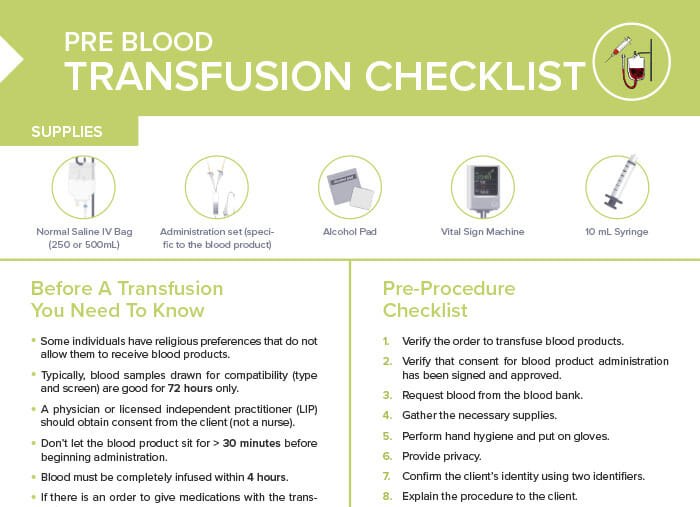Nursing Knowledge
A blood transfusion is a medical procedure where a client receives donated blood or blood products into their bloodstream. It’s typically used to replace blood lost due to surgery or injury, or when the body cannot produce blood properly because of an illness. A health care provider orders the transfusion and a consent is signed by the client.
Blood transfusions involve introducing donated blood or blood components (like red blood cells, plasma, or platelets) into a patient’s bloodstream through an intravenous (IV) line. The body uses the donated blood as if it was its own, using the red cells for oxygen transport, platelets to aid clotting, and plasma for various functions including clotting and immunity.
Indications for blood transfusions include:
There’s no set hemoglobin level/RBC count that universally requires a blood transfusion. However, according to guidelines from the American Association of Blood Banks (AABB), a transfusion is often considered when the hemoglobin level is less than 7 to 8 grams per deciliter in stable, non-bleeding patients.
The number of blood transfusions a patient diagnosed with cancer can have depends on their individual condition, the type and stage of cancer, and the treatment they’re undergoing. Some patients may require multiple transfusions over a period of time due to anemia caused by chemotherapy or the cancer itself. Each transfusion must be considered individually to balance its potential benefit against its risks.
A blood transfusion typically takes 1–4 hours for one unit of blood, but this can vary depending on the specific situation.
Jehovah’s witnesses refuse blood transfusions based on religious beliefs that another’s blood is not used to sustain life. It’s important for healthcare providers to respect these beliefs and explore alternative treatment options, whenever possible.

Bring this with you when getting ready to administer a blood transfusion and never forget one of the prep steps again!
Transfusion reactions are adverse events that occur during or after a blood transfusion. They can include:
Note: DO NOT flush the line if a patient transfusion reaction is suspected to avoid any further blood product administration.
The Rhesus (Rh) factor is a specific protein found on the surface of red blood cells. People are either Rh positive (have the protein) or Rh negative (don’t have the protein). Before a blood transfusion, it’s vital to know a person’s Rh factor to prevent a possible immune response.
RELATED TOPIC:
Free Download
Master the topic with a unique study combination of a concise summary paired with video lectures.
USMLE™ is a joint program of the Federation of State Medical Boards (FSMB®) and National Board of Medical Examiners (NBME®). MCAT is a registered trademark of the Association of American Medical Colleges (AAMC). NCLEX®, NCLEX-RN®, and NCLEX-PN® are registered trademarks of the National Council of State Boards of Nursing, Inc (NCSBN®). None of the trademark holders are endorsed by nor affiliated with Lecturio.
Your free account gives you access to:
or
Have a holly, jolly study session 🎁 Save 50% on all plans now >>